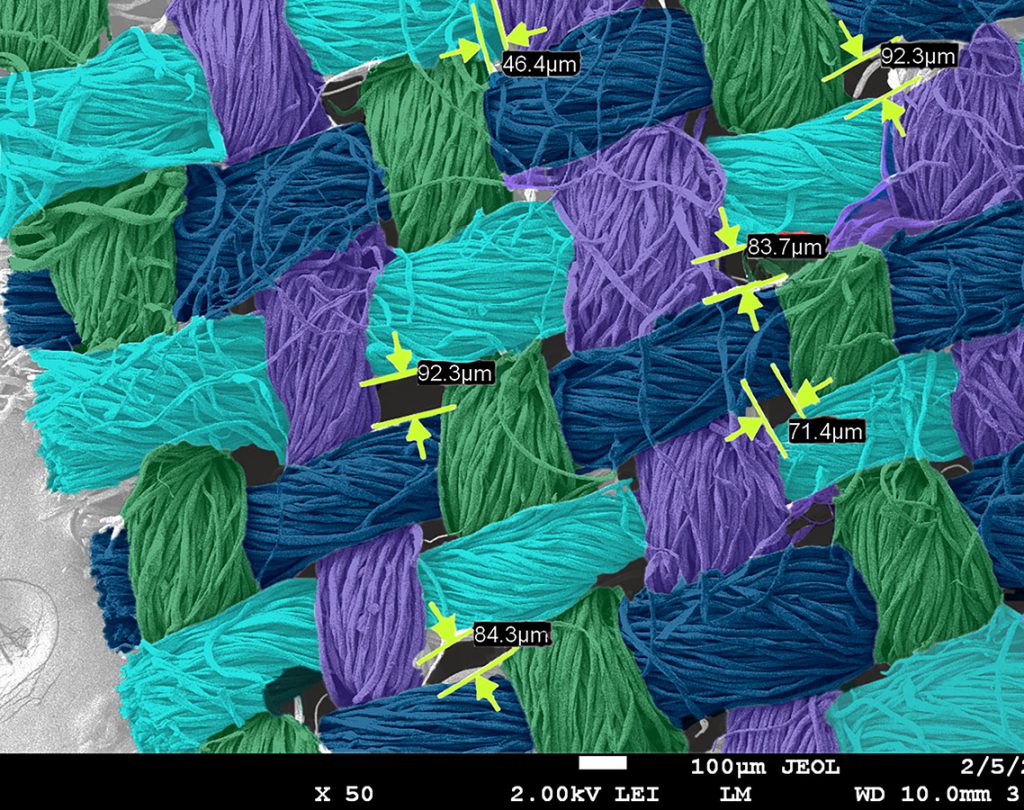The science is clear that widespread masking can reduce the spread of COVID-19. But which type of face covering is most effective at trapping the tiny droplets that carry the virus?
Through a unique program at The University of Toledo, hundreds of elementary, middle and high school students have been able to use sophisticated scientific instruments to make that determination for themselves.

In this colorized photo from one of SCOPE’s mask sessions, a bandana is shown at 50x magnification with measurements that demonstrate the size of the gaps between the woven strands of fabric.
“With our electron microscope, students can see the structure of different masks in great detail and get a better idea of why some materials may be more effective than others,” said Dr. Kristin Kirschbaum, director of the UToledo Instrumentation Center and creator of the SCOPE program. “Masks are part of their life right now, so the students really care about it.”
The SCOPE program gives K-12 students a rare perspective into the world around them along with a taste of what academic research is really like.
With the guidance of UToledo scientists, students are able to remotely control a pair of high-powered microscopes that can magnify samples up to 1 million times.
Under the leadership of Kirschbaum and program coordinator Cassandra Zamora, more than 4,000 students have participated in SCOPE since the program launched a decade ago.
“I think this opens a whole new world to them. They don’t really know how research is done and they can’t relate to it. It’s something that other people do,” Kirschbaum said. “All of a sudden, they see the research, they get the confidence that they could run sophisticated equipment. They feel empowered.”
Normally the sessions are beamed into classrooms where students are able to control the microscope from a single computer. But as the pandemic sent schools fully remote, the SCOPE program quickly shifted to enable students to control the microscopes from their own homes via their laptops.
Recognizing the interest in face coverings, Kirschbaum’s team, which includes Zamora and Dr. Jennifer Gadient, created a new session to allow students to analyze nine different types of masks and filters.
UToledo scientists first provide an overview of the size of droplets, aerosols and the virus that causes COVID-19. Students as young as fourth grade are then able to use a $500,000 scanning electronic microscope to see how the fabric of common masks are layered and woven, as well as measure the gaps between those fibers.
For example, KN-95 masks are irregular and multilayered. Bandanas and spandex gaiters, on the other hand, are uniformly woven and have much larger gaps between the fibers. The magnification allows students to see how those materials might capture particles or allow them to pass through holes in the fabric.
To date, more than 250 students from five middle schools and high schools and two east coast colleges have participated.
“The big thing for me is it’s not just us showing them, they do it themselves. The students can sit there at the end of a session and decide by themselves that this mask must be better than that one,” Kirschbaum said. “It also helps students to understand why mask wearing is important.”
The mask session is one of the SCOPE program’s most popular sessions to date. In addition to local schools, the now fully remote program is able to work with students in Indiana, Michigan, New Jersey, Rhode Island and Virginia.
Upcoming sessions are scheduled with three more schools, providing the program to more than 200 additional students.